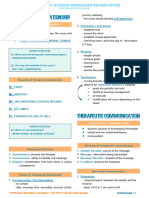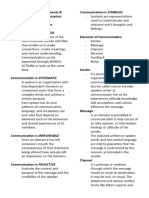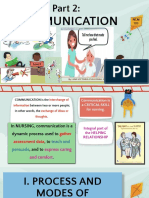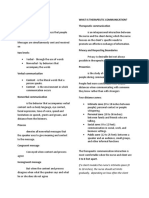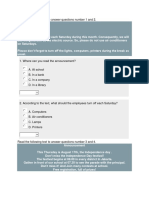0 ratings0% found this document useful (0 votes)
12 viewsNCMHAS1 Midterms
NCMHAS1 Midterms
Uploaded by
Schuyler Riotoc1. Therapeutic communication involves the exchange of verbal and nonverbal information between a nurse and patient to effectively meet patient needs and care standards.
2. Key aspects of therapeutic communication include maintaining appropriate distance, using touch only when welcome, actively listening, and observing nonverbal cues to understand the patient's perspective.
3. Cultural considerations, spiritual beliefs, and understanding the full meaning and context of what is communicated are also important aspects of effective therapeutic communication.
Copyright:
© All Rights Reserved
Available Formats
Download as DOCX, PDF, TXT or read online from Scribd
NCMHAS1 Midterms
NCMHAS1 Midterms
Uploaded by
Schuyler Riotoc0 ratings0% found this document useful (0 votes)
12 views3 pages1. Therapeutic communication involves the exchange of verbal and nonverbal information between a nurse and patient to effectively meet patient needs and care standards.
2. Key aspects of therapeutic communication include maintaining appropriate distance, using touch only when welcome, actively listening, and observing nonverbal cues to understand the patient's perspective.
3. Cultural considerations, spiritual beliefs, and understanding the full meaning and context of what is communicated are also important aspects of effective therapeutic communication.
Original Description:
Health Assessment Notes
Original Title
NCMHAS1-Midterms
Copyright
© © All Rights Reserved
Available Formats
DOCX, PDF, TXT or read online from Scribd
Share this document
Did you find this document useful?
Is this content inappropriate?
1. Therapeutic communication involves the exchange of verbal and nonverbal information between a nurse and patient to effectively meet patient needs and care standards.
2. Key aspects of therapeutic communication include maintaining appropriate distance, using touch only when welcome, actively listening, and observing nonverbal cues to understand the patient's perspective.
3. Cultural considerations, spiritual beliefs, and understanding the full meaning and context of what is communicated are also important aspects of effective therapeutic communication.
Copyright:
© All Rights Reserved
Available Formats
Download as DOCX, PDF, TXT or read online from Scribd
Download as docx, pdf, or txt
0 ratings0% found this document useful (0 votes)
12 views3 pagesNCMHAS1 Midterms
NCMHAS1 Midterms
Uploaded by
Schuyler Riotoc1. Therapeutic communication involves the exchange of verbal and nonverbal information between a nurse and patient to effectively meet patient needs and care standards.
2. Key aspects of therapeutic communication include maintaining appropriate distance, using touch only when welcome, actively listening, and observing nonverbal cues to understand the patient's perspective.
3. Cultural considerations, spiritual beliefs, and understanding the full meaning and context of what is communicated are also important aspects of effective therapeutic communication.
Copyright:
© All Rights Reserved
Available Formats
Download as DOCX, PDF, TXT or read online from Scribd
Download as docx, pdf, or txt
You are on page 1of 3
THERAPEUTIC COMMUNICATION Social (4-12 ft)
Public (12-25 ft)
Therapeutic communication: most
Communication
comfortable when nurse and patient are 3-6
- Exchange of info
ft apart.
- Verbal
Context: literal words spoken
THERAPEUTIC COMMUNICATION #4
Context: environment, circumstances,
Touch
situation in which communication
Five types: functional/professional;
occurs.
social-polite; friendship-warmth; love-
- Nonverbal
intimacy; sexual-arousal.
Process: all messages used to give
Comforting and supportive when
meaning, context to message
welcome and permitted.
Congruent or incongruent messages
Can be possible invasion of intimate and
personal space.
Therapeutic Communication #1 The nurse must evaluate use of touch
based on the client’s preferences,
Interpersonal interactions; focus on
history, and needs.
client’s needs
Nurse may find touch supportive, client
Need for privacy
may not.
Encompasses goals that facilitate the
nursing process
Needed to effectively meet the
THERAPEUTIC COMMUNICATION #5
standards of client care.
Active listening (concentrating
exclusively on what patient says)
Active observation (watching nonverbal
THERAPEUTIC COMMUNICATION #2
actions as speaker communicates)
GOALS OF THERAPEUTIC COMMUNICATION
These help the nurse:
Establish therapeutic nurse-client
- Recognize the most important issue
relationship.
- Know what questions to ask
Identify the most important client’s
- Use therapeutic communication
concerns; Assess client’s perceptions.
technique
Facilitate client’s expression of
- Prevent jumping to conclusions
emotions.
- Objectively respond to message
Teach client and family the necessary
self-care skills.
Recognize client’s needs.
VERBAL COMMUNICATION SKILLS #1
Implement interventions to address
Need for concrete, not abstract,
client’s needs.
messages
Guide client toward acceptable
Techniques
solution.
- Exploring, focusing, restating, reflecting,
etc.
- Some promote discussion of feelings or
THERAPEUTIC COMMUNICATION #3
concerns in more depth.
PROXEMICS
- Other techniques useful in focusing or
Distance zones
clarifying what is being said.
Intimate (0-18 in)
Personal (18-36 in)
- Feedback via making an observation or Nondirective role (broad openings,
presenting reality open-ended questions)
VERBAL COMMUNICATION #2 Directive role (direct yes-or-no
Avoidance of non-therapeutic questions; usually for clients with
techniques suicidal thoughts, in crisis, or who are
- Advising, belittling, challenging, out of touch with reality)
probing, reassuring
Interpretation of signals or cues THERAPEUTIC COMMUNICATION SESSION #4
- Overt (clear, direct statements) Asking for clarification
- Covert (vague, indirect messages) Addressing client’s
NONVERBAL COMMUNICATION SKILLS #1 ASSERTIVE COMMUNICATION
Facial expression Expression of positive and negative
- Expressive feelings/ideas in an open, honest, direct
- Impassive way
- Confusing - Calm, specific, factual statements
Body language - Focus on “I” statements
- Closed body position Possible responses
- Open posture - Aggressive
- Passive-aggressive
- Passive
NONVERBAL COMMUNICATION SKILLS #2 - Assertive
Broken record technique
UNDERSTANDING MEANING, CONTEXT, AND
UNDERSTANDING MEANING, CONTEST, AND SPIRITUALITY OF COMMUNICATION #2
SPIRITUALITY OF COMMUNICATION #1
Meaning: messages often contain more
meaning than just spoken word.
Spirituality
- Self-awareness of own spiritual beliefs VERBAL COMMUNICATION
- Need for objectivity and nonjudgmental - Goal of the interview process: to elicit
attitude about client’s beliefs as much data about the client’s health
status as possible
Cultural Considerations
Consideration assessment Types of Questions:
Use of a translator who can retain the Open-ended question
original intent without inserting biases - Used to elicit client’s feelings and
perceptions.
THERAPEUTIC COMMUNICATION SESSION #2 - “How” or “what”
Initiation of session Close-ended question
- Introduction - Used to obtain facts and to focus on
- Establishment of contract for specific information.
relationship - “when” or “did”
- Identification of major concern:
THERAPEUTIC COMMUNICATION TECHNIQUES:
REPHRASING
- Helps clarify information the client has
stated
You might also like
- Drama Sleeping BeautyDocument13 pagesDrama Sleeping BeautyDian Fitri100% (3)
- County of Alameda: Request For Proposal No. 901688 Next Generation Security PlatformDocument55 pagesCounty of Alameda: Request For Proposal No. 901688 Next Generation Security PlatformNurul Ain Mohd NorNo ratings yet
- Target Financial Statement AnalysisDocument6 pagesTarget Financial Statement AnalysisTJ WelbornNo ratings yet
- Gray G B - Studies in Hebrew Proper Names - 1896Document365 pagesGray G B - Studies in Hebrew Proper Names - 1896Vassilis LaspiasNo ratings yet
- Nga Morehu (9781927131312) - BWB Sales SheetDocument2 pagesNga Morehu (9781927131312) - BWB Sales SheetBridget Williams BooksNo ratings yet
- Chapter 6 PsychiaDocument2 pagesChapter 6 PsychiaunknownNo ratings yet
- Therapeutic CommunicationDocument17 pagesTherapeutic CommunicationJoab StainesNo ratings yet
- 1.1 Active Listening and Communication SkillsDocument6 pages1.1 Active Listening and Communication SkillsNica Lopez Fernandez100% (1)
- Midterm ReviewDocument4 pagesMidterm Reviewkittycat16100% (1)
- Purcom ReviewerDocument2 pagesPurcom Reviewergimboongaling489No ratings yet
- Midterm ReviewDocument4 pagesMidterm Reviewkittycat16No ratings yet
- Noting Nonverbal BehaviorDocument6 pagesNoting Nonverbal BehaviorEricson CandelariaNo ratings yet
- IPC Reviewer CommunicationDocument4 pagesIPC Reviewer CommunicationLauren S.No ratings yet
- Communication Skills NursesDocument29 pagesCommunication Skills NursesSamayanaboyana BabuNo ratings yet
- Communication Techniques in Conducting Health AssessmentsDocument2 pagesCommunication Techniques in Conducting Health AssessmentsA R F I J U LNo ratings yet
- Funda - MidtermDocument13 pagesFunda - MidtermreignashoellietutorNo ratings yet
- NCM 104 Rle PrelimDocument18 pagesNCM 104 Rle PrelimJiro Luis KatindigNo ratings yet
- Basic Concepts of Nursing Notes by Lovely Jovellanos BSN 1-4Document9 pagesBasic Concepts of Nursing Notes by Lovely Jovellanos BSN 1-4Love Jovellanos ÜNo ratings yet
- Therapeutic CommunicationDocument6 pagesTherapeutic Communicationraquel maniegoNo ratings yet
- Digital Notes On Psychiatric Nursing PDFDocument21 pagesDigital Notes On Psychiatric Nursing PDFEnna EstrellaNo ratings yet
- CommincationDocument31 pagesCommincationUrdu KahaniNo ratings yet
- Reviewer in Ged 106 CommunicationDocument2 pagesReviewer in Ged 106 Communicationmeanantig08No ratings yet
- Purposive Communication (Reviewer)Document2 pagesPurposive Communication (Reviewer)blainechloeNo ratings yet
- Therapeutic CommunicationDocument53 pagesTherapeutic CommunicationJosh LimNo ratings yet
- LECTURES With HilightDocument17 pagesLECTURES With Hilightmomlas2021No ratings yet
- COMMUNICATION (Nursing)Document6 pagesCOMMUNICATION (Nursing)gracebel reyesNo ratings yet
- Purposive Communication LECTUREDocument7 pagesPurposive Communication LECTUREJazzel MartinezNo ratings yet
- 7 - CommunicationDocument50 pages7 - CommunicationJaymark BlancoNo ratings yet
- Therapeutic Communication SeminarDocument13 pagesTherapeutic Communication SeminarPihu SalamNo ratings yet
- Week 2 Lecture Notes Fundamentals of NursingDocument8 pagesWeek 2 Lecture Notes Fundamentals of NursingGrazelle Joyce OcampoNo ratings yet
- Presentasi Kuliah Konsep Dasar Komunikasi ProfesionalDocument30 pagesPresentasi Kuliah Konsep Dasar Komunikasi ProfesionalTessa Amanda SavetriNo ratings yet
- Class NotesDocument6 pagesClass NotesdocjenniferfranciadamoNo ratings yet
- CommunicationDocument2 pagesCommunicationJudylyn SakitoNo ratings yet
- Purposive CommunicationDocument6 pagesPurposive CommunicationThea MarieNo ratings yet
- Communication (Reviewer)Document5 pagesCommunication (Reviewer)James Lord GalangNo ratings yet
- LESSON 1. Communication in The Twenty-First CenturyDocument26 pagesLESSON 1. Communication in The Twenty-First Century2021315379No ratings yet
- Oral Communication SEM 1 - 1ST QDocument11 pagesOral Communication SEM 1 - 1ST QgwynethcharizredondoNo ratings yet
- Purposive CommunicationDocument8 pagesPurposive CommunicationBelle JundarinoNo ratings yet
- NCM 103 Lecture Part 2 CommunicationDocument77 pagesNCM 103 Lecture Part 2 CommunicationArabela PelotaNo ratings yet
- DIASS Q2 Mod4Document19 pagesDIASS Q2 Mod4Eivra Senreiv100% (1)
- GE PurposivDocument25 pagesGE PurposivjsmnrklvrNo ratings yet
- Purposive Communication Prelim ReviewerDocument6 pagesPurposive Communication Prelim ReviewerJade PaulosNo ratings yet
- Therapeutic Communication and Nurse - Patient RelationshipDocument58 pagesTherapeutic Communication and Nurse - Patient RelationshipMelbin W MNo ratings yet
- Purposive CommunicationDocument12 pagesPurposive Communicationangeltheegg123No ratings yet
- Chapter 1 - Communication Processes, Principles and EthicsDocument32 pagesChapter 1 - Communication Processes, Principles and EthicsLyka Loren EspañaNo ratings yet
- 12-Doctor- Patient CommunicationDocument15 pages12-Doctor- Patient Communicationbldylayla1422No ratings yet
- Study Guide Psych Nursing 4Document14 pagesStudy Guide Psych Nursing 4christine mercadoNo ratings yet
- Ch.3 The InterviewDocument9 pagesCh.3 The InterviewJose R. MendozaNo ratings yet
- Occ Long Quiz ReviewerDocument3 pagesOcc Long Quiz Revieweriesha limNo ratings yet
- If A Client Invades The Nurse's Intimate Space (0 To 18 Inches), The Nurse Should Set Limits Gradually, Depending On How Often The ClientDocument2 pagesIf A Client Invades The Nurse's Intimate Space (0 To 18 Inches), The Nurse Should Set Limits Gradually, Depending On How Often The ClientCamila BuadoNo ratings yet
- TRA Psychiatric NursingDocument10 pagesTRA Psychiatric NursingGil GanibanNo ratings yet
- Therapeutic Communication Mine LecDocument79 pagesTherapeutic Communication Mine LecMarielle DasugoNo ratings yet
- Oral Com ReviewerDocument4 pagesOral Com ReviewerLee Andrei AlarconNo ratings yet
- Assignment in Psychiatric Nursing: Submitted To: Ms. Jessica DG. Areja RN, RM Submitted By: Judith R. Dela CruzDocument11 pagesAssignment in Psychiatric Nursing: Submitted To: Ms. Jessica DG. Areja RN, RM Submitted By: Judith R. Dela Cruzjudith dela cruzNo ratings yet
- THERAPEUTICDocument1 pageTHERAPEUTICSalazar, Lourish Ann G. BSN2-CNo ratings yet
- Reviewer Business ComDocument17 pagesReviewer Business ComHAZEAL MENDOZANo ratings yet
- Communication and DocumentationDocument4 pagesCommunication and DocumentationCamille SanguyoNo ratings yet
- GMRC Notes MidtermssDocument4 pagesGMRC Notes Midtermssmain.23001392No ratings yet
- REVIEWERDocument9 pagesREVIEWERAtty Joven Allen AsidoNo ratings yet
- Practically Speaking Chapter 1: Public Speaking: An Act of Communication Where There Is An Identified Speaker FormallyDocument4 pagesPractically Speaking Chapter 1: Public Speaking: An Act of Communication Where There Is An Identified Speaker Formallyanelim villaNo ratings yet
- Bacteria FDocument9 pagesBacteria FKrisha CafongtanNo ratings yet
- NCM 103B Lecture Notes Nurse-Patient InteractionDocument2 pagesNCM 103B Lecture Notes Nurse-Patient InteractionRay Daniel E. BilbaoNo ratings yet
- Week8 Communicating OUTLINEDocument4 pagesWeek8 Communicating OUTLINEemman.magtibayNo ratings yet
- Communication: Anil VermaDocument15 pagesCommunication: Anil Vermaaniket yadav0006No ratings yet
- The Art of Conscious Communication: Transforming Difficult ConversationsFrom EverandThe Art of Conscious Communication: Transforming Difficult ConversationsNo ratings yet
- Manufacturing Process DiagramDocument3 pagesManufacturing Process DiagramCris Diane G. DatingginooNo ratings yet
- BIM Proj Execution PlanDocument27 pagesBIM Proj Execution PlanEdward CNo ratings yet
- Role of Chorus in Oedipus RexDocument2 pagesRole of Chorus in Oedipus RexTehreem KhalidNo ratings yet
- 190 Number BingoDocument17 pages190 Number BingoVaanmatheNo ratings yet
- Financial Analysis Cheat Sheet 1709070577Document2 pagesFinancial Analysis Cheat Sheet 1709070577herrerofrutosNo ratings yet
- Read The Following Text To Answer Questions Number 1 and 2Document4 pagesRead The Following Text To Answer Questions Number 1 and 2chefa foreverNo ratings yet
- LKPD Pertemuan 1 Daily RoutineDocument7 pagesLKPD Pertemuan 1 Daily RoutineArifah laily nur aini100% (1)
- 2024 TEACHER NEED ANALYSIS TEMPLATE-blankDocument65 pages2024 TEACHER NEED ANALYSIS TEMPLATE-blankElmer EstuistaNo ratings yet
- The Rhetoric of Malcolm XDocument13 pagesThe Rhetoric of Malcolm Xgideon mbathaNo ratings yet
- Major Reasons of Dismemberment of East PakistanDocument3 pagesMajor Reasons of Dismemberment of East PakistanIqra HafeezNo ratings yet
- SAP E - S4HCON2020 Exam Practice Test Instant Access - No Installation RequiredDocument6 pagesSAP E - S4HCON2020 Exam Practice Test Instant Access - No Installation RequiredKrishna VamshiNo ratings yet
- Or Forever Hold YourDocument59 pagesOr Forever Hold Yourmillenaantunes4No ratings yet
- Pas TutDocument9 pagesPas TutHằng HàNo ratings yet
- Irregular and Regular VerbDocument14 pagesIrregular and Regular VerbhotmianNo ratings yet
- Music in MetresDocument20 pagesMusic in Metressuchitra_tajaneNo ratings yet
- Astm A956-22Document13 pagesAstm A956-22jesus.cwiengineerNo ratings yet
- LeeyaDocument27 pagesLeeyaJerome LatojaNo ratings yet
- 1 - Hello Neighbour!Document4 pages1 - Hello Neighbour!theTomBoy_PrincessNo ratings yet
- Personal Letter ExerciseDocument3 pagesPersonal Letter ExerciseArdhya GaNo ratings yet
- Tra Disclosure: To Assist Them in Evaluating ApplicationsDocument1 pageTra Disclosure: To Assist Them in Evaluating ApplicationsCamilo CoronilNo ratings yet
- Padilla V Padilla 74 Phil 377Document5 pagesPadilla V Padilla 74 Phil 377Charmaine MejiaNo ratings yet
- Course Description:: FY 1000 19F (29260) The Ethics of EngagementDocument11 pagesCourse Description:: FY 1000 19F (29260) The Ethics of EngagementNathan Pardieu100% (1)
- Hook Point Slide DeckDocument57 pagesHook Point Slide DeckChristine Mwaura100% (4)
- IWRBS M14 MacdonaldvenidaDocument18 pagesIWRBS M14 MacdonaldvenidaGlennCorpuzNo ratings yet
- Sakulich Academic BioDocument3 pagesSakulich Academic Bioicps.researchNo ratings yet



















